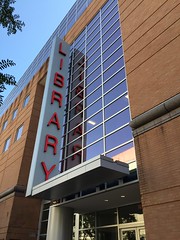 Two years ago, the Syracuse University iSchool Public Libraries Initiative (IPLI) became interested in the IMLS Public Library Survey (PLS) data. At the time, the IPLI was doing some work on the data in conjunction with the EveryLibrary Institute. Seeing the data from every public library in our 50 U.S. states, the District of Columbia, and our U.S. territories raised questions in us. Exploring those questions took time and required adding some skills to our team, while also understanding which of our questions were answerable and how many were not. Fast forward and I have finally finished a 17-page report using the 2017 PLS data entitled Public Library Survey Data: Some Answers, Many Questions. The report is available as a free-download.
Two years ago, the Syracuse University iSchool Public Libraries Initiative (IPLI) became interested in the IMLS Public Library Survey (PLS) data. At the time, the IPLI was doing some work on the data in conjunction with the EveryLibrary Institute. Seeing the data from every public library in our 50 U.S. states, the District of Columbia, and our U.S. territories raised questions in us. Exploring those questions took time and required adding some skills to our team, while also understanding which of our questions were answerable and how many were not. Fast forward and I have finally finished a 17-page report using the 2017 PLS data entitled Public Library Survey Data: Some Answers, Many Questions. The report is available as a free-download.
If you work in a public library in the U.S., you might not even know that your library - through your state library - contribute to this huge data set, which is available for anyone to use. Yes, one row for every public library (main/central) library in the one data file, and one row for every library outlet in the other (i.e., branch libraries and bookmobiles). Thousands of rows and dozens of columns. There is data about public library staffing, budget, services, and more. While there is much that this data can tell us about our public libraries, there are many questions that cannot be answered. Those unanswerable questions frustrated us and we tried to give voice to some of them.
Why care about this report?
I think you should read this report in order to look at U.S. public libraries from a different point of view. You are likely focused on your library or the libraries in your region. What if you took a step back and looked at public libraries more broadly? What could you learn?
One important lesson we learned is that public libraries have not documented their histories as much as we had hoped. One of our initial questions was, "Why have public libraries selected their specific legal structures?" Why, for example, is your library a municipal library and not an association library? Perhaps some libraries have documented their thought process or maybe the decision was made for them. However, what we found important is that this history is not readily available and likely lost. This, by the way, was the impetus for Heather Elia's article entitled "The Do's and Don'ts of Documentation."
Report description
The federal Institute of Museum and Library Services (IMLS) collects and reports on key data points about public library activities, behaviors, expenditures, and staffing annually in the United States. Pre-COVID era data is important to interrogate and understand because the framework for the COVID-pivot starts with library activities on the day of the shutdowns. In the research paper in "Public Library Survey Data: Some Answers, Many Questions", Syracuse University Emeritus Professor of Practice Jill Husrt-Wahl presents a thoughtful discussion of the 2017 IMLS Public Library Survey data as more than past history. She writes, "Comparing this year, for example, to a previous year will tell the story of the negative impact COVID-19 had on some parts of the library, as well as the positive impact it had on other areas, such as ebook and database usage. Some libraries may use their data to point to the level of funding and staffing it would like to return."
In "Public Library Survey Data: Some Answers, Many Questions",
Hurst-Wahl takes us through several data points to interrogate both the
underlying reports as well as questioning the conventional wisdom about
critical interrelated issues like the legal structure of public
libraries, the staffing comportment of libraries, and the ways that
properly-funded libraries express their mission, vision, and values. The
crux of this discussion focuses on the role and importance of library
staff, regardless of their job title or classification. "We know that
this [IMLS] definition does not capture everything that public library
staff does, especially considering both physical and virtual spaces,"
writes Hurst-Wahl. "This definition does not reflect the depth of
community services that members of the staff provide." This report
attempts to connect these dots and offers library leaders valuable
insights for planning for success in a COVID-impacted world.
Thanks to...
Additional Resources
- The podcast T is for Training talked about this report on its Oct. 8 episode - show notes, audio link. The show notes include resources listed in the episode.
- EveryLibrary Institute Library Funding Map
- Measures that Matter - This is worth knowing about. It is an initiative begun in 2016 to help coordinate a field-wide conversation around library data collection with the aim to develop and implement a related action plan.
No comments:
Post a Comment